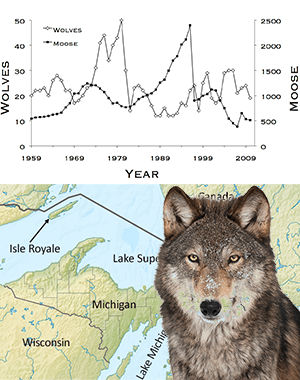
Students explore community interactions on Isle Royale, a small island located in Lake Superior. Wolves migrated to the area in 1950 when an ice bridge formed between the island and Canada.
The island was also home to moose, small animals, and a variety of plant life, enough to sustain the wolf population. (The island is about 32 square miles.) Fifty years later, only two wolves remain on the island. What caused the wolf decline?
Students first consider the community interactions by creating a possible food web of the island’s inhabitants. A graph showing predator-prey interactions reveals the cyclical nature of the wolves and moose. The graph also shows that in 1980, a large drop in wolf numbers occurred, likely due to parvovirus. This drop caused a bottleneck effect in the wolf population, reducing their genetic diversity.
Subsequent research showed that many of the wolves suffered from spinal deformities, likely due to inbreeding. Over a decade, the population continued to decline until there were only two left, a male and female who were also related.
With the decline of the predators on the island, the moose population increased. Scientists became concerned that the herbivore population would deplete the resources on the island, which would affect other animals on the island. The U.S. National Park Service made to relocate wolves from the mainland to the island to replenish the wolf population. Students must decide if this was a good idea using data from the case.
Ecological Principles
This case study explores many topics related to an ecology unit.
- Predatory Prey Cycles
- Trophic cascades
- Keystone species
- Carrying capacity
- Wildlife management
- Genetic drift / Bottleneck Effect
This activity could be used with any age group, though I would use more direct instruction with freshman students. AP biology students can complete this independently, after they have some background information on community interactions.
Chapter 44-47 in Openstax Biology 2e covers these topics. You are welcome to view my Google Slide presentation on ecology, or browse the list of topics at the Ecology Unit Page for the class.

